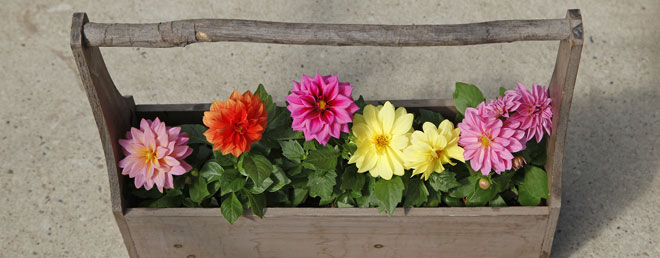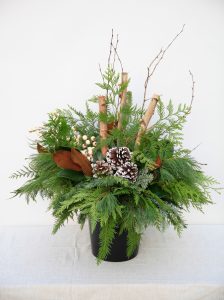Growing Dahlias
There are few things more captivating than the full- throated, operatic colour of a dinner plate dahlia in radiant bloom. Once a treasured flower in Empress Josephine’s garden, dahlias now bring a burst of pure, broad colour to Canadian yards.
Many Canadian gardeners shun these summer stunners, thinking that they’re difficult to grow. While they certainly aren’t hardy to our climate, the colour bursting forth like an aria makes it well worth the effort of overwintering tubers.
Starting them Indoors
Dahlia tubers are hard to miss in March as they crowd the shelves of garden centers and box stores alike. When shopping, read the box carefully as the are thousands of cultivars available. If you’re looking for a big dinner pate dahlia, you’d be disappointed to discover a smaller variety popping up.
Be picky with your tubers. Large, plump tubers tend to be the showiest bloomers. Feel inside the package and if they’re shriveled, small, or desiccated, keep moving.
With our woefully short growing season, it’s best to plant the tuber indoors in march. Frost is fatal, so wait until the end of May to move them outdoors.
Dahlias are accustomed to the well drained, sandy soils of their native Mexico. Layer the bottom of your pot with a few inches of pebbles before panting to make sure the roots aren’t waterlogged.
Choose a well draining soil and plant the so the tuber’s crown is just below the surface. Add some peat moss as they prefer things slightly acidic.
Ideally, they should be transplanted at about 12 inches high. Take a deep breath and snip off the central branch when you plant them out. This encourages a bushy, well-branched dahlia.
Dahlias Outdoors
If your garden soil is mostly clay, add a generous dose of horticultural sand or peat moss before planting. For the biggest flowers, throw in a few handfuls of rich black compost.
Dahlias are heavy feeders, so fertilize monthly with a high middle number, like 15-30-15, to promote flowering. Let the soil dry between watering, but water heavily when you do.
Watch for hungry slugs, especially if you have a mature garden with leaf litter and other debris lying around. Slugs love dahlias, so if they move in lay down a margarine lid full of beer and let them drink to a drunken demise.
How you treat the buds depends on whether you want the flowers to be large or numerous. If you’re going for the giant, 10″ wide flower, snip buds off the side branches to make the plant invest more resources into the central buds.
If you’d rather have a sustained show of colour than a few giant blooms, let the buds develop naturally. Pinch them off promptly as the blossoms fade to encourage new bud development.
Dahlias are a classic statement making cut flower, often lasting for a week or more indoors. Cutting them as the buds open should yield more blooms.
Overwintering your Dahlias
Dahlias, like most plants, aren’t hardy in our zone. The tubers will, however, get larger and the flowers more impressive over the seasons if you bring it indoors over the winter.
To store dahlia tubers, cut the plants down to 4 inches above the ground just before the first freeze up (hopefully getting some cut flowers while you’re at it). Dig a wide circle around the tuber and gently lift it up, peeling and shaking the dirt as you go.
Store it indoors in a cool, dark, dry place (treat it like storing a potato). The next spring you’ll start with a bulb even bigger than the spring before!
















